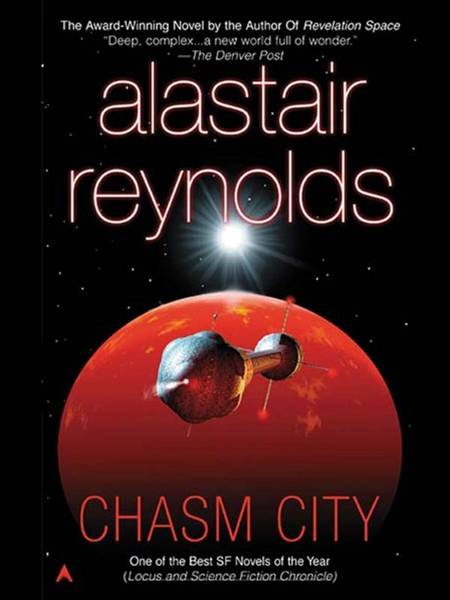
All that glitters turns to rust
Alastair Reynolds has some tricks up his sleeve. I’ve observed this pattern in the two novels of his I’ve read so far, *Revelation Space* and *Absolution Gap*: I notice at some point when I’ve gotten a good way into the book that it doesn’t seem surprising and that I’m not getting much out of it, then just before I begin to lose interest there’s a subtle twist I hadn’t anticipated and I get hooked in.
In the case of *Chasm City* I think I was prejudiced because the book is told in the first person. The effect was that the narrative came off a bit like a dime-store detective novel. I like genre fiction just fine, but I’ve come to expect more from Reynolds.
I need not have worried. What seemed like a cheap device turned out to be an important part of telling the story. There were shifts in perception integral to the plot that could not have been revealed so deftly in the third person. The protagonist’s point of view becomes a very important part of the story. Some details were revealed slowly, like they are in mystery writing, and the impartial eye of the third-person narrator would have shone too harsh a light on these developments.
What those developments are I shan’t spoil for anyone, but once the novel hit its stride I found it hard to put down. This is much like how I read the other two of Reynolds’ novels. The first hundred pages took me a few weeks, and then the last five or six hundred pages went by in a flash.
This is entirely to Mr Reynolds’ credit. He allows not just his plot and his characters but his locations and even histories to unfold at a pace that does not give the reader much to work with at first, but as the novel progresses, the parts begin to fit together. It requires attention and curiosity but the aspects eventually merge and mesh.
As a reader of other of Reynolds’ novels, I was pleased to see some historical gaps filled by *Chasm City*. While there were no characters from the other books and short stories I’ve read before, I was pleased to learn more about the locations that played a part in the other stories. Yellowstone, Sky’s Edge, the Glitter Belt/Rust Belt and of course Chasm City each get revealed more fully in this novel where in the others much of the locations’ history is hinted at or assumed. In *Chasm City*, Reynolds shows us more of the big picture of the universe he’s painting and the revelations are welcome.
All that being said, *Chasm City* has some shortcomings. The final resolution of the conflict between the characters smacks of a *deus ex machina* plot device, and there are entire subplots that, while interesting and entertaining, do not have any direct bearing on the plot. Like many modern movies, the story contains climax but not much in the way of denouement. Although I enjoyed reading *Chasm City* and find it to be well above average sci-fi, I believe it falls somewhat short of Reynolds’ other novels.